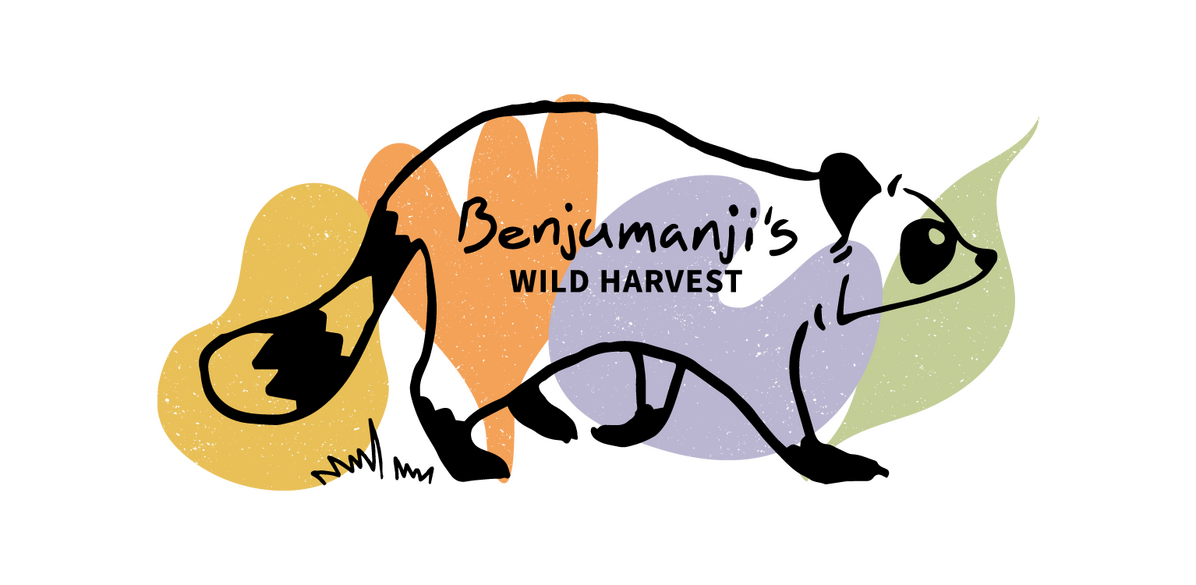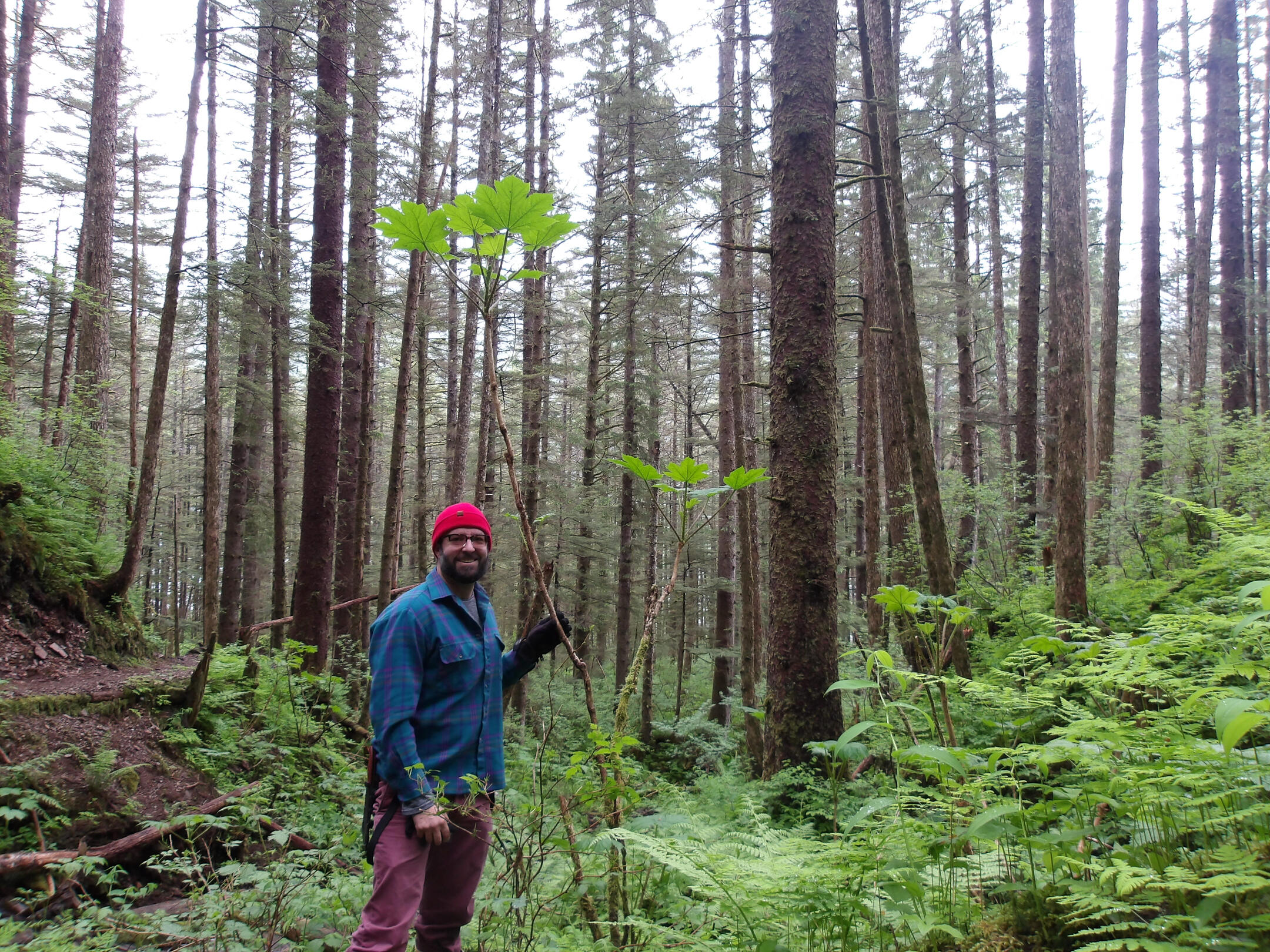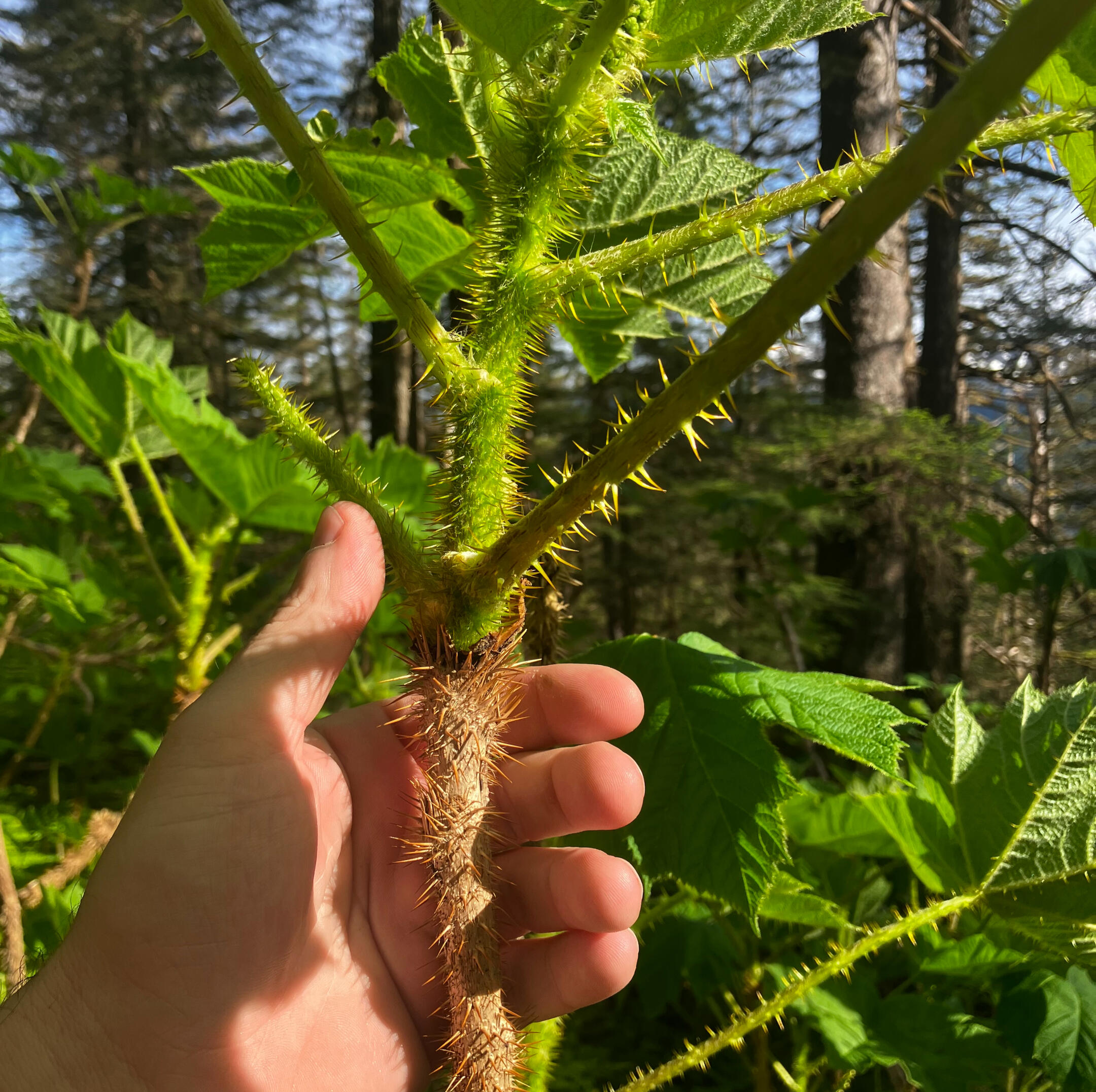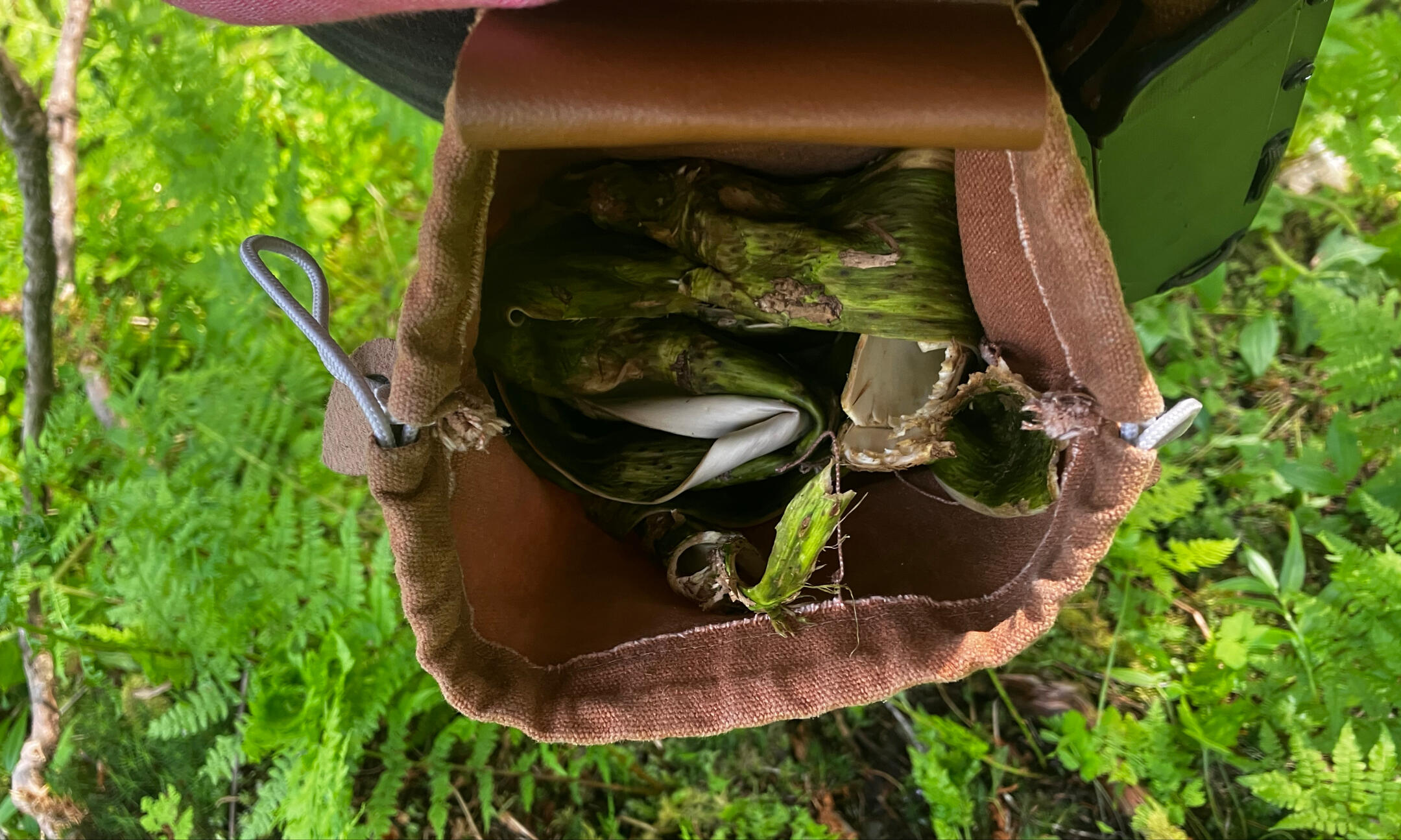welcome to

Benjumanji is a journey of self discovery that is growing from the heart out. The core of this project is about meeting people and connecting ourselves to the natural world through stories of travel, tutorials on harvesting food, medicine, and practical craft materials, then sharing these limited-supply offerings with the community. Our page is currently under construction, but read on for a few snippets and visit us on Instagram to watch the story unfold.

wild harvested
Devil's Club Salve
Oplopanax Horridus: Oplo = Armored Panax = ‘Heal-All’ and Horridus = Fierce.
This fiercely armored “heal-all” has powerful anti-inflammatory and antimicrobial properties that, made into a topical salve, can be used to treat eczema, soothe achey muscles, diminish the appearance of scars, fight infection in cuts, and much more.Dig Deeper and hear the story of how Devil’s Club set us on our personal path of healing, learn the recipe for making your own Devil’s Club salve, and discover how to harvest this miraculous plant…Naturally.

Know More
Our story
Benjumanji was born somewhere along a 15 year road of constant travel. Many of these years were spent guiding hikes and adventure sports in wild areas, but few other avenues along the way were left unexplored. From lobster boats in Maine, to botanical nurseries in Florida; restoration projects in Hawaii’s rainforest to climbing crags in Arizona’s Saguaro desert; from South America, to its antipode in Southeast Asia. Through countless adventures we created memories and acquired knowledge from the friends we made along the way. Since we cannot not walk both paths and be one traveler, we have shared as many bittersweet “goodbyes” as we have warm welcomes continuing down the road less traveled. Benjumanji is meant to reunite these friends, yourself included, first through this website, and someday soon in the forest…naturally.

Join the conversation
Get in touch
The most fruitful conversations about harvesting are those had by many people. If you found your way to our landing page it is probably because we have previously crossed paths in person. Regardless, please feel free to message me below with any question, comments, or stories of your own and I will be certain to write back.
We Appreciate it
Thank you
I look forward to sharing my journey with you.

The Story Of
Devil's Club
When first introduced to Devil’s Club 16 years ago I greeted it the same as most hikers, warily. Devil’s Club grows in colonies. Rhizomes reach out horizontally across the soft moss of the forest floor to jutting generations of spiky stalks surrounding their ancestral center. In the thick of the Alaskan Rainforest, an innocently misplaced step on any one of these connections can be quickly be punished by sending the towering stalk collapsing downward like a medieval implement of destruction.
We all experience moments in life that change us forever. As they are occurring these moments may seem inconsequential. Then, some time later, hindsight blends the peripheral seamlessly into its center. Seeing the picture now whole, we start to recognize ourselves as inseparable from the paths we’ve traveled. For me, meeting this fierce healer was one such moment.

My picture began quite small. I was just on my way to have a little adventure. Yet, somewhere in my subconscious there must have been a notion of what image would later form. I was hired for a job that was seasonal and, when compared to my current vocation, a bit silly by most standards. At the time I was regional operations manager for a national advertising company. The job I was hired for in Alaska was guiding zip-line tours during the warm season. I had no prospects for anything after October when the winter rushes in and drives all the tourists back south. Never the less, I gave away my apartment, left my “respectable” job without a word of notice, sold all the belongings that didn’t fit into my backpack, and blindly headed north to Alaska.
Upon arriving, I headed directly into the forest with the intent of making it my home. At the time my outdoor experience was limited to overnight camping trips, a couple years of rock climbing, and a small library of books and poems by travelers that I held fast at heart. Needless to say, a calamity of errors were soon follow. The water, my god! It was inescapable! I’ve now lived on enough mountain tops, beaches, and river banks to recognize it’s formidable power to change both lives and landscapes in the blink of an eye. At that time I just thought, ‘What’s a little rain? I’m not made of sugar’. It came down from the sky and penetrated my tents waterproof barrier in a matter of hours. It came up from the ground and soaked my clothes and bedding. The air itself was saturated so that even when the sun peaked out nothing would dry. Soon, everything I owned was covered in mildew and I was starting from scratch.
I thumbed my way into town and returned for round two armed with an arsenal of tarps, dry bags, and, this time, an actual plan. A few weeks still lie ahead of struggling against the constant wet and creatures going bump in the night, but eventually I made the curve and learned enough to feel comfortably at peace in my wooded domicile. I slept nestled at the sharp angle of a deeply cut creek where the water turned east to meet the sea. Though only a creek by classification, it was a raging torrent that carried a constant cool breeze above boisterous rapids that spoke to me while I lay silently in my bed at night. My tent was now elevated above the water that filtered constantly through the duff toward the creek , and small channels were dug to surround the site and direct any pooling water immediately away. A hundred paces downstream from the ‘bedroom’ was ‘the kitchen’ where large rocks stacked cylindrically in an eddy acted as my refrigerator. Dry food hung from limbs overhead, and in the hollow cubby beneath the trunk of a spruce was where I stowed my cookware. In the other direction, twenty paces upstream, to combat cabin fever I constructed a seating area by tensioning tarps against the flexible flapping arms of the hemlock trees. The tarps were pitched perpendicular to each other and folded over so that they dropped at three points funneling the abundance of drinking water into small cisterns. At the front of the structure was a wall of firewood with a doorway left open at its center. The pile was also constructed from Hemlock trees which I had learned to be the only reliable source of firewood available. This lesson was taught to be by a stranger called Jay who came one night to my camp whilst wandering in search of wolf traps to disarm. The traps were set by one Falcon McAllister, a man who I would later have the displeasure of meeting in person at a local bar, but that’s another story all together. Jay derived such a tremendous amount of pleasure in thwarting the trappers efforts that I count myself very lucky that he would pause long enough to teach this lesson. He explained that Hemlocks die from the inside out and bottom up, leaving them standing with their bark in tact and thus protecting the dry wood from the rain. Because the bedrock is shallow and the ground soft, one can easily rock the tree and use it’s own momentum to send it avalanching to the ground, shattering into so many pieces that little work is required to turn it into usable firewood. Up until then I had been using a small camp stove to heat water for freeze dried meals, but the warmth and light of a camp fire cut through the cold grey and was a tremendous help in lifting my spirits.
So that was home. Most of the time I was by myself with the exceptions of the voice of the creek and whatever curious woodland creature would wander my way. Jay came back a couple more times and taught me to supplement my freeze dried meals with the food that surrounded me. He taught me about the edible berries, leaves, teas, and about the incredible healing properties of the Devil’s Club Plant that I had been trying so desperately to avoid. It would still be years before I made my first batch of Devil’s Club Salve, but his lessons provided far more than sustenance; they connected me to the land I had previously been struggling against.

I think most of us are taught from a young age that it takes a lot hard work to make it in this world. In my personal experience, no matter how hard I worked and no matter how successful I was at a given task, I was always left feeling empty and disconnected. Social skills have never been a strong suit of mine and remain to this day something that I study rather than coming naturally. What I found in the forest, however, is that I belong by nature of my very existence. This is true for each and every one of us. Television shows might have us believe that wild spaces are something to survive… or perhaps even conquer. I argue that modern constructs make it far more difficult to survive than any natural elements. To put food on our tables we must first survive to a certain age, educate ourselves, impress the boss at a job interview, and then work long hours every day before we earn the privilege of going to the grocery store to forage our food. In the natural world, food grows up from the ground and hangs down from the branches. Our water falls from the sky as it cycles through every creek, river, pond, lake, and great ocean on the planet. Our cells are sustained by the oxygen produced by the grass and trees. Every atom of our being resonates and participates in a homeopathic relationship with the world around us. We belong here. You belong here. I’m not trying to say that we shouldn’t be careful for our wellbeing while exploring wild places, certainly we should. The forest is full of innumerable incalculables. However, once we learn to see things correctly, and also conduct ourselves correctly, we find ourselves closer to our ancestral center and gain perspective on the big picture: Ourselves, inseparable from our surroundings.

Of course, learning this affected me greatly and I had no interest returning to my former lifestyle. I began travel in all directions, having all kinds of experiences. As often happens when one is changed by learning something new and exciting, I blush to admit how enlightened I felt during that time. I felt above the modern world. But, as time goes by and the lessons continue to grow, my ego continues to shrink. I realize now that I have been hiding in nature to avoid the modern world, which is every bit as counter-productive as hiding in the modern world to avoid nature. It’s all connected. One great habitat. So in this phase of my life I’m learning to reconnect and I’m doing that by sharing my strange self through stories. I am no expert of any kind and don’t pretend to be. I’ve heard it said, ‘the best conversations about responsible harvesting are those held by many people’. My goal is to start conversations and I hope as we continue traveling our respective paths that one day they cross, whether it be in the city, or in the wild freedom of the forest… naturally.
how to
Harvest Devil's Club
Devil’s Club can be found in the coastal rainforest of coastal Alaska, extending southward through Canada, and ending in the mountains of the Pacific Northwest. A second disjunct population can also be found in Ontario and Michigan surrounding Lake Superior.Your toolkit for harvesting:1) “Loppers”- I have seen a number of tools used, but the cleanest and most effective tool is definitely a pair of “loppers” - Large pruning sheers with a long handles that are capable of harvesting stalks with a wide diameter in a single, low-impact, motion.2) A knife - Once again, I have seen, and used myself, a number of different tools that work perfectly well for cleaning a stalk of Devil’s Club. I’ve used paintbrush cleaners, various kitchen tools, and even the edge of plastic cards from my wallet in a pinch. Despite its formidable appearance, cleaning devils club is a delicate process that we will discuss in detail later. Anything with a bit of a stiff edge will do, but what I find most effective and also convenient is to simply use the soft edge of the BACK of my knife.3) Gloves - Devils is densely armored with thorns and stinging hairs that penetrate the skin and fester for days and even weeks. A good sturdy pair of gloves will keep you from learning the art of removing these very painful nuisances.4) A bag or backpack - This is simply to carry your tools and, if you like, transport your harvested Devil’s Club to a more comfortable environment for processing. I enjoy harvesting my Devil’s Club and then moving next to a stream to clean it.The process I’ve learned and used for harvesting is as follows:1) The first step to harvesting is to find a suitable specimen. Devil’s Club, at least where I harvest in Alaska, is a prevalent plant that is easily found. It grows abundantly in well drained soil and for that reason you often find it on terrain with a certain degree of inclination. Once found, one kind consideration you may choose to make is how heavily the area is trafficked. This medicine is widely used by many people for achey muscles and arthritis. I like to wander far from the trail and leave the low-hanging fruit for those who may not have that same privilege traveling off the beaten path.
A second consideration is that Devil’s Club grows in generational colonies. Upon finding a patch of Devil’s club, trace it lineage by following the connecting rhizomes at the base from one stalk to the next. Eventually you will find the “grandmother” at the center. You should always harvest the YOUNGEST generation as this will keep the family in good health and able to recover and reproduce quickly.2) Make your cut at the base of the plant above the rhizome. Not to get preachy, but I suggest taking a moment express your gratitude for what you are receiving by considering how you might give back. If the plant is fruiting you may consider scattering its seeds. You may also consider breaking down the leaves you remove from its crown in the next step so that they compost more easily and don’t block sunlight from the undergrowth.3) Next we prepare the plant for cleaning by removing all leaves, lumps, and other protrusions. This makes it easier to remove the thorns and outer bark in the next step. As mentioned briefly before, I like to move to a comfortable place near a running body of water to remove the bark (The airflow keeps the mosquitos at bay and also carries away the scrapes of bark, thus reducing visual pollution). For that reason, at this time I cut the stalk into pieces and pack them to someplace comfortable.4) Removing the outer bark and thons is accomplished by running a firm edge up and down the stalk. Depending on point of the season in which you are harvesting and the health of the plant, the thorns and thin outer-bark has many different personalities that range from a dry crackly skin that comes off wonderfully easily, to wet closely-clinging skin that seems to have itself embedded into the softer portion underneath. The fleshy and fragrant portion beneath the bark is the cambium layer from which we will extract the medicine. It bruises easily and requires a soft touch. Begin with the lightest pressure possible and increase pressure until you expose the bright green cambium layer.4) With the stalk safely stripped of all its armor, the next step is to remove the cambium “skin” from the stalk. Use the tip of your knife to carefully cut a single slit down the length of the stalk. Then, gently pull the edges away and peel it off. If you are a hunter this might feel similar to skinning an animal. More often than not, this is a very easy process. If the skin is clinging to the stalk and proving difficult to remove, use the blade of your knife like a vegetable peeler. This is still a relatively easy process it just a little messier.*The stalk itself is absolutely GORGEOUS. It has a wonderful alabaster finish that is somehow soft and impossible hard at the same time. At its center is a spongy core that is easily removed. Once cut into pieces, sanded, and center removed, Devil’s Club stalk makes magnificent beads. Of course, with a creative mind it could be used for many things.5) The final step before making Salve (recipe provided in the following section) is to dry the cambium “skin”. Once again, this can be achieved a number of ways. It can be placed in the sun, which takes 24-48 hours in a dry environment (Difficult to create in the rainforest). It can also be placed in the oven a low temperature and the door cracked which usually takes 5-6 hours. Obviously, running your oven for 5-6 hours with the door open is less than ideal unless it’s a cold day out and provides the dual purpose of heating your home.
The most efficient method is if you have a car. Place the cambium on your dashboard with your defrosters on and your windows open while running errands. It will only take about 45 minutes to 1 hour before it’s bone dry.
how to
Make Devil's Club Salve
At the time of writing this my recipe is know to me by touch, sight, and smell. For that reason, the measurements listed are approximate. However, all the information necessary to make a successful batch of salve at home is provided below. Next season I will buy a scale and note exact measurements to share with the community.Ingredients1) Dried, crushed Devil’s Club. This is used in a 1:2 ratio with you carrier oil. 1 part Devil’s club to 2 parts oil.2) Olive Oil.3) Vitamin E oil. This acts as a preservative. I add 5% vitamin E oil to my solution4) Beeswax. This provides the texture for the salve. START SMALL. I start 6% by volume (Approximately 1/4 cup for a 32oz jar of oil)5) Essential Oils. Feel free to add your personal favorite here based on your personal needs and favorite scents. You can increase the antimicrobial properties with tea tree or soften the the scent with floral or citrus… I think lavender and cedar go nicely with natural scent of Devil’s club. The amount of oil can be added to your preference as well, but I typically us add 1% by volume.Step 1) Crush dried Devil’s Club finely and add to container filling 1/2 way.
Step 2) Add Vitamin E oil to container
Step 3) Fill the remained of the container with Olive Oil to 1” below the rim
Step 4) Heat container in a crock pot for 24 - 48 hours on LOW heat.
Step 5) Strain out the organic material and filter oil. This is a very important step. It’s easiest to first run the oil through mesh strainer or colander to remove all the large organic material. Then, line the strainer or colander with paper towels and filter again to remove all the fine sediment.
Step 6) Add beeswax. Begin with approximately 6% as suggested and then test the consistency by taking a spoonful and placing in the freezer for 3-5 minutes. Add more beeswax a little at a time until the desired consistency is achieved. At a minimum, the salve should be a stable solid at room temperature.
Step 7) Add desired amount of essential oils
Step 8) Transfer salve to whatever jar or tin you will be using SEAL WITH LID as it cools to help keep the solution cool evenly.For technical information on the chemical and pharmacological makeup of Devil's Club visit: